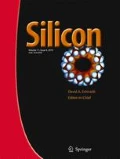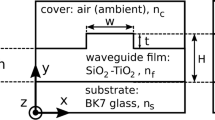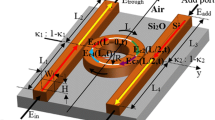Abstract
Terahertz (THz) sources have attracted special attention for various applications. Compared to the standard silica-based optical fibers, silicon waveguides have more advantages such as higher refractive index and lower absorption loss over the THz region. In this paper, for the first time, a rib silicon waveguide based on the photonic crystal (PC) idea is designed and by using the scalar modulation instability (SMI) phenomenon, tunable wavelength conversion for THz wave generation is simulated. By changing the structural parameters such as the air-hole diameter of the PC and infiltration of optical fluids into the air holes, linear and nonlinear characteristics of the waveguide are controlled and hence the generated THz radiation is considered as a tunable source. Simulation presents that the maximum converted wavelength, 326.17 μm, is obtained when the air-hole diameter is set at d = 0.86 μm and the pump wavelength is in the normal dispersion regime. Also, we have infiltrated optical fluids into PC air holes in order to change the dispersion properties of the waveguide while keeping the geometrical parameters unchanged. This led to converted wavelengths of 70.5, 76.8 and 107.5 μm, all located in the THz region. The loss of this waveguide is less than 0.8\( \raisebox{1ex}{$ dB$}\!\left/ \!\raisebox{-1ex}{$ cm$}\right. \), which is less than that of previously reported in similar silicon waveguides.
Similar content being viewed by others
Data Availability
Data are available on request from the authors.
References
Zhang XC, Xu J, (2010) Introduction to THz wave photonics. Springer; New York.
Pawar AY, Sonawane DD, Erande KB, Derle DV (2013) Terahertz technology and its applications. Drug Invent. Today. 5(2):157–163
Lewis RA (2014) A review of terahertz sources. J. Phys. D J Phys D Appl Phys. 47(37):374001 (11pp)
Burford NM, El-Shenawee MO, (2017) Review of terahertz photoconductive antenna technology. Opt. Eng. 56(1):010901(21pp).
Yang X, Brunetti E, Jaroszynski DA (2018) High-energy coherent terahertz radiation emitted by wide-angle electron beams from a laser-wakefield accelerator. New J. Phys. 20(4):043046
Evain C, Szwaj C, Roussel E, Rodriguez J, Le Parquier M, Tordeux MA, Ribeiro F, Labat M, Hubert N, Brubach JB, Roy P (2019) Stable coherent terahertz synchrotron radiation from controlled relativistic electron bunches. Nat. Phys. 15(7):635–639
Franckié M, Faist J (2020) Bayesian optimization of terahertz quantum cascade lasers. Phys. Rev. Appl. 13(3):034025
Ravi K, Huang WR, Carbajo S, Nanni EA, Schimpf DN, Ippen EP, Kärtner FX (2015) Theory of terahertz generation by optical rectification using tilted-pulse-fronts. Opt. Express 23(4):5253–5276
Piyathilaka HP, Sooriyagoda R, Dewasurendra V, Johnson MB, Zawilski KT, Schunemann PG, Bristow AD (2019) Terahertz generation by optical rectification in chalcopyrite crystals ZnGeP 2, CdGeP 2 and CdSiP 2. Opt. Express 27(12):16958–16965
Wang Z, Liu H, Huang N, Sun Q, Wen J (2012) Efficient terahertz-wave generation via four-wave mixing in silicon membrane waveguides. Opt. Express 20(8):8920–8928
Soref RA, Emelett SJ, Buchwald WR (2006) Silicon waveguided components for the long-wave infrared region. J. Opt. A: Pure Appl. Opt. 8(10):840–848
Yin L, Lin Q, Agrawal GP (2007) Soliton fission and supercontinuum generation in silicon waveguides. Opt. Lett. 32(4):391–393
Driscoll JB, Osgood RM, Grote RR, Dadap JI, Panoiu NC (2015) Squeezing light in wires: fundamental optical properties of Si nanowire waveguides. J. Light. Technol. 33(14):3116–3131
Agrawal GP (2013) Nonlinear Fiber Optics5th edn. Academic Press, San Diago
Pakarzadeh H, Derakhshan R, Hosseinabadi S, (2019) Tunable wavelength conversion based on optofluidic infiltrated photonic crystal fibers. J. Nonlinear Opt. Phys. Mater. 28(01):1950002(17pp).
Psaltis D, Quake SR, Yang C (2006) Developing optofluidic technology through the fusion of microfluidics and optics. Nature 442(7101):381–386
Ebnali-Heidari M, Dehghan F, Saghaei H, Koohi-Kamali F, Moravvej-Farshi MK (2012) Dispersion engineering of photonic crystal fibers by means of fluidic infiltration. J. Mod. Opt. 59(16):1384–1390
Bedoya AC, Domachuk P, Ting J, Grillet C, Monat C, Tomljenovic-Hanic S, Lee MW, McPhedran RC, Eggleton BJ, (2010) Optofluidic dispersion engineering of photonic crystal waveguides. In Conference on Lasers and Electro-Optics 2010 May 16 (p. CWM4). Optical Society of America.
Tatian B (1984) Fitting refractive-index data with the Sellmeier dispersion formula. Appl. Opt. 23(24):4477–4485
Crisp J and Elliott B, (2005) Introduction to fiber optics. 3rd Edition, Elsevier.
Pakarzadeh H, Akbari F (2021) Propagation of Terahertz Pulses in Photonic Crystal-Based Rib Silicon Waveguides. Silicon. https://doi.org/10.1007/s12633-021-01092-6
Zhu Z, Brown TG (2002) Full-vectorial finite-difference analysis of microstructured optical fibers. Opt. Express. 10(17):853–864
Pakarzadeh H, Rezaei SM, Namroodi L (2019) Hollow-core photonic crystal fibers for efficient terahertz transmission. Opt. Commun. 433:81–88
Saitoh K, Koshiba M (2005) Numerical modeling of photonic crystal fibers. J. Light. Technol. 23(11):3580–3590
Pakarzadeh H, Rezaei SM (2016) Modeling of dispersion and nonlinear characteristics of tapered photonic crystal fibers for applications in nonlinear optics. J. Mod. Opt. 63(2):151–158
Pakarzadeh H, Hosseinabadi S, Amiri IS, (2019) Designing a silicon waveguide for tunable wavelength conversion in terahertz region. In Seventh International Conference on Optical and Photonic Engineering 2019 Oct 16 (Vol. 11205, p. 1120504). International Society for Optics and Photonics.
Ionin AA, Kinyaevskii IO, Klimachev YM, Kozlov AY, Kotkov AA (2017) A Broadband Infrared Laser Source (2.5–17 μm) for Plasma Diagnostics. Phys. At Nucl. 80(11):1635–1641
Sorokina IT, Ebrahim-Zadeh M, (2008) Mid-Infrared Coherent Sources and Applications. Springer Netherlands.
Hale GM, Querry MR (1973) Optical constants of water in the 200-nm to 200-μm wavelength region. Appl. Opt. 12(3):555–563
Anderson MR, (2000) Determination of infrared optical constants for single component hydrocarbon fuels. MISSOURI UNIV-ROLLA, (Master Thesis).
Author information
Authors and Affiliations
Contributions
All authors contributed to the study conception and design. Material preparation, simulation results and analysis were performed by H. Pakarzadeh and S. Hosseinabadi. The first draft of the manuscript was written by S. Hosseinabadi and all authors commented on previous versions of the manuscript. All authors read and approved the final manuscript.
Corresponding author
Ethics declarations
Compliance with ethical standards is followed by authors.
Informed Consent
Not applicable.
Consent to Participate
Not applicable.
Consent for Publication
Not applicable.
Conflict of Interest
The authors declare that they have no potential conflicts of interests.
Research Involving Human Participants and/or Animals
Not applicable.
Additional information
Publisher’s Note
Springer Nature remains neutral with regard to jurisdictional claims in published maps and institutional affiliations.
Rights and permissions
About this article
Cite this article
Pakarzadeh, H., Hosseinabadi, S. & Amiri, I.S. Tunable Terahertz Wavelength Conversion Based on Optofluidic Infiltrated Rib Silicon Waveguides. Silicon 14, 6097–6106 (2022). https://doi.org/10.1007/s12633-021-01278-y
Received:
Accepted:
Published:
Issue Date:
DOI: https://doi.org/10.1007/s12633-021-01278-y




